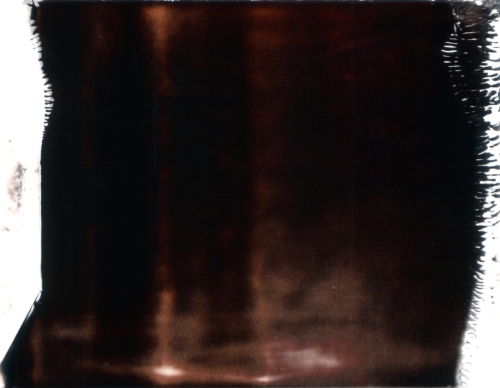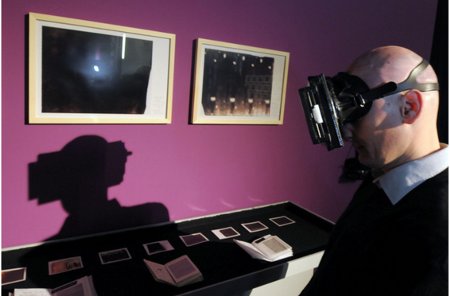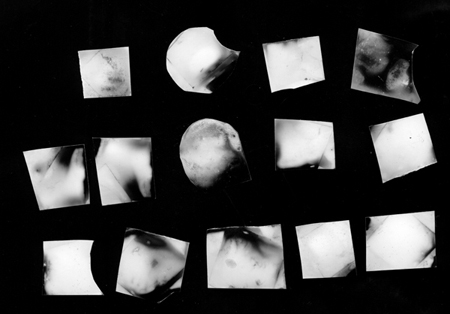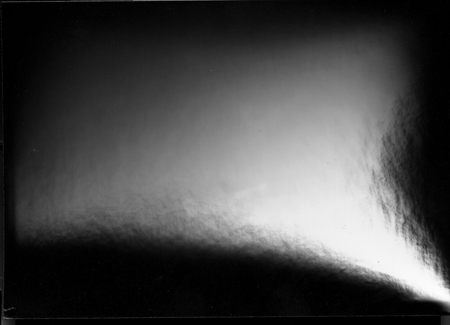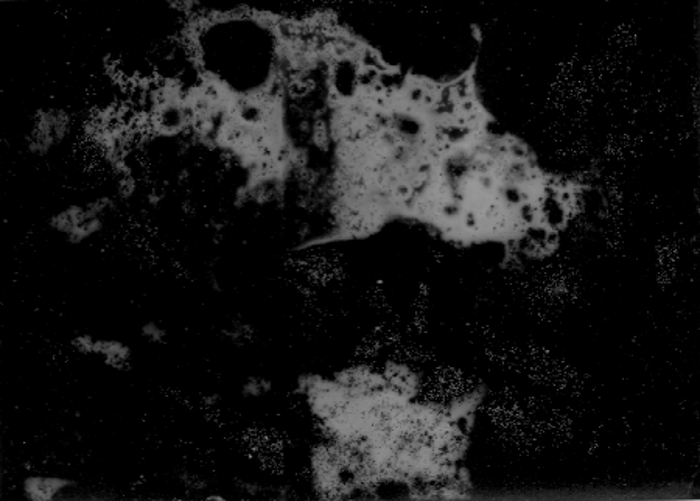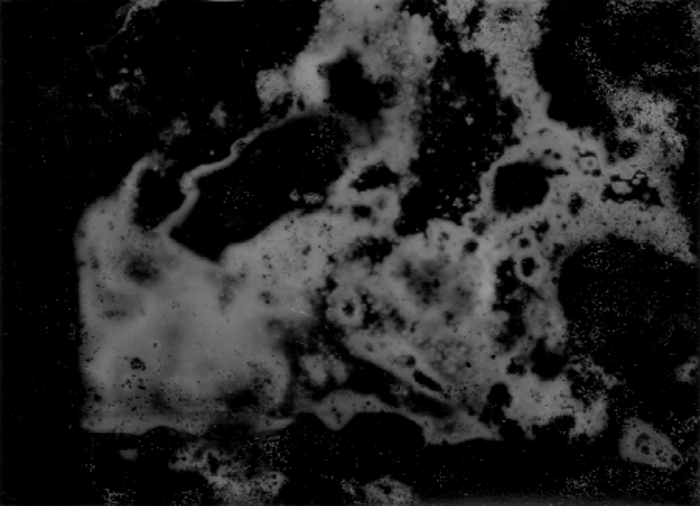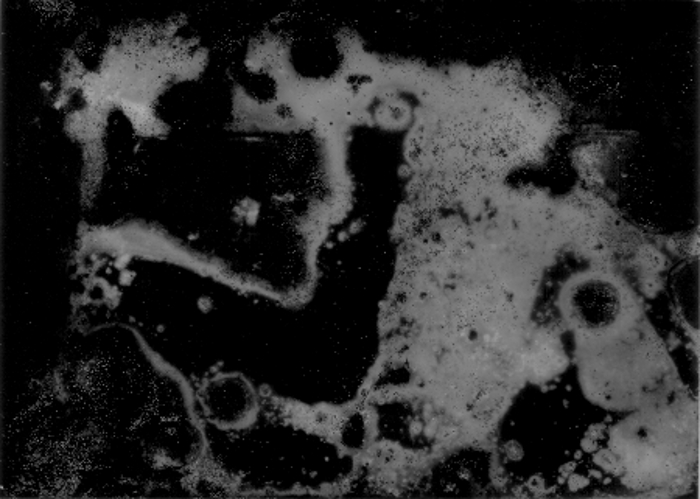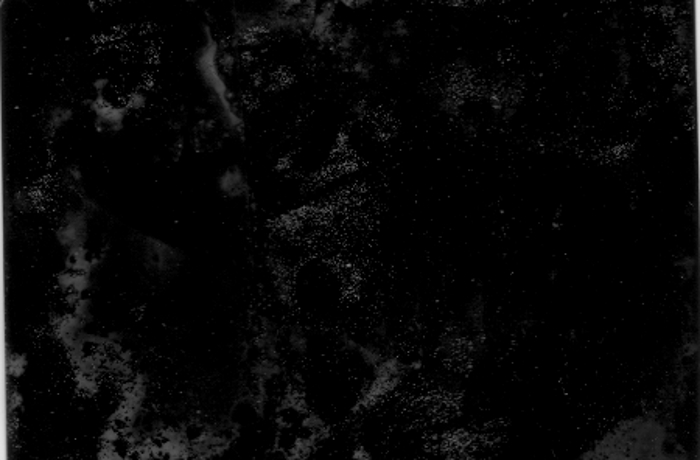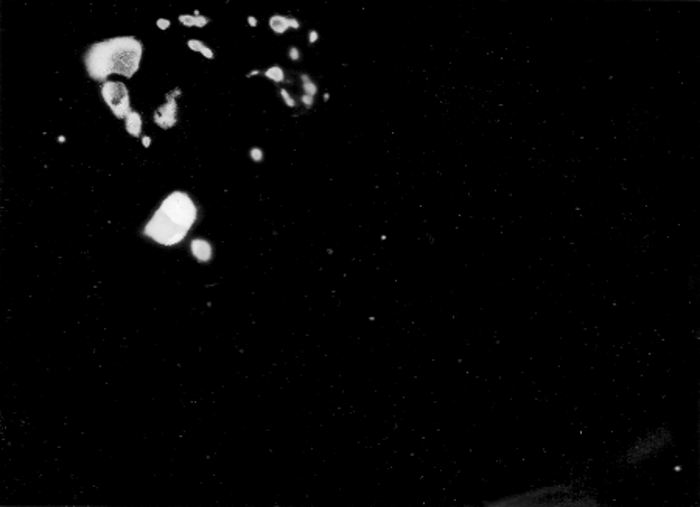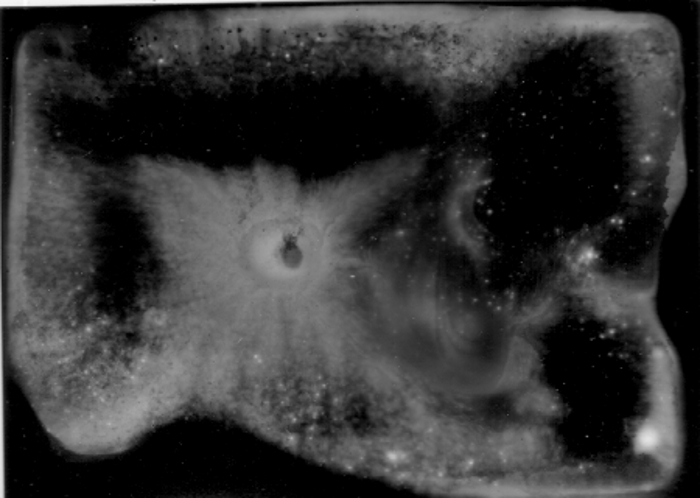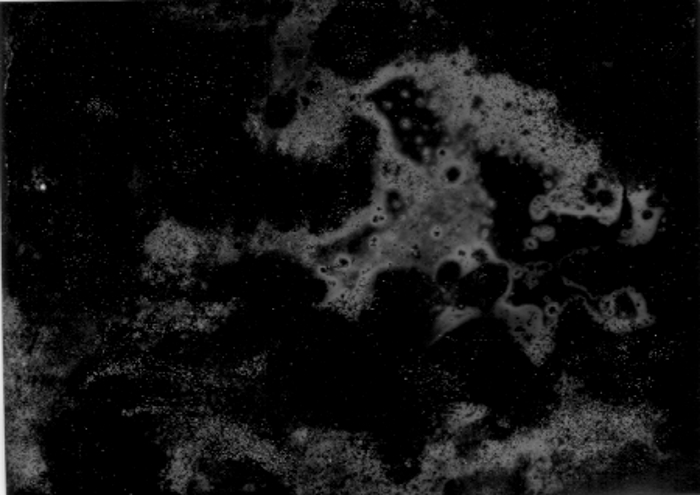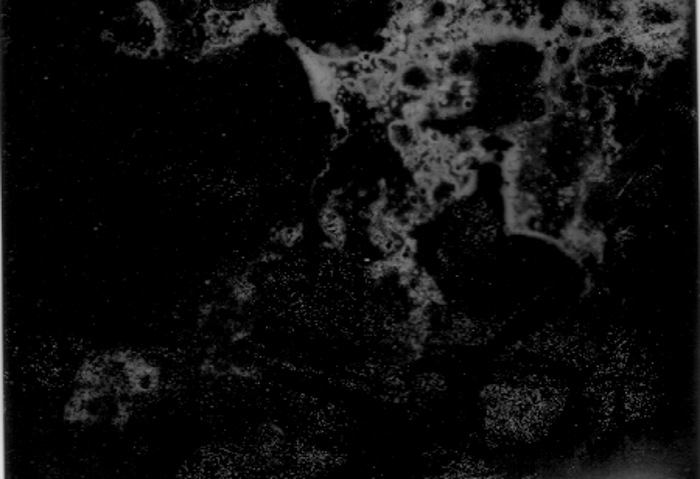Photographing the invisible - Thought-o-graphic experiments
The air itself is one vast library, on whose pages are for ever written all that man has ever said or woman whispered and the ‘earth, air and ocean are the eternal witnesses of the acts we have done’. Charles Babbage
Image: exposure through the kamera for thoughtography and intraocular lights, by Kathrin Gucnter
* Thought-o-graphy or thought-photography means to influence and expose light sensitive, photographical material through the power of an invisible, so called magnetic fluidum, emitted by human or animal beings, objects and interferences in smaller or larger environments.
* Thoughtographic exposure may - but not necessarily has to - ignore any traditional camera or photographic recording device, and is often achieved without any source of visible light.
Short historical excursion:
Thought is a radiant, creative, almost material power, the fiat lux of the bible. During the process of thinking, the soul turns the atoms of the brain into waves and makes its phosphor glow. With concentrating ones thought onto any object with simple outlines, like a bottle for example, the fluidic thought image will be forced out through the eyes to expose itself through the power of its glow onto the photographic plate. The result is a photographic image. Louis Darget, 1911
A virtual fluidum, a magnetic power, a so called animal organic magnetism, discovered in the 18th century by Franz Anton Mesmer, acclaimed German medical and practitioner of hypnosis, is the starting point of a largely controversial field of research which, over centuries has occupied the work of many scientists, psychologists and mediums both skeptics and supporters.
According to Mesmer the entire atmosphere and consequently everything and every living being is inhabited and surrounded by this virtual, magnetic fluidum. Illnesses or diseases for example are signs of magnetic imbalance in the body. Medicals who are also educated in magnetising would be able to re-imbalance the missing fluid throughout magnetic brushings. Patients, under the influence of hypnosis, claim to have seen above mentioned invisible magnetic powers in different shining colors.
Ever since, numerous scientists and parapsychologistsدhave devoted their life long researches to proof and capture this virtual fluidum on photographic plates. Especially after 1895, with the discovery of the invisible X Rays through C.G. Roentgen, a sheer beam of differently called rays came to light and sight to the public eye.
Freiherr von Reichenbach for example called it the Od or Od Licht, exclusively visible in the darkness and to so called sensitive persons only. Louis D'Arget named this phenomenon Vital Fluid or V-Rays, which could not only be transferred throughout the eyes onto the photographic plate but also through the very fingertips and directly in the development tray. Hyppolite Baraduc called his exposures Iconographies focusing especially on the power of religious pilgrimage places, where the invisible rays got emitted through the power of the believing masses. Lefranc experimented with a so called photographie des sentiments, Rene Blandlot detected that alleged N - Rays (N for Nancy) were able to brighten up sparks or phosphor when they got hit by them. Further investigations by Fjodor Ochorowitz and his Mediums brought up X to the power of x rays transmitted by so called mediamine lights. In Japan, Tomokichi Fukurai, was forced to leave his professorship of the Royal University of Tokyo after the publication of his book Clairvoyance and Thoughtography where he described his then unique thought-o-graphical experiments in combination with clairvoyance.
The latest and last documented thought-o-graphic phenomenon - at least known to the western world - was the American medium Ted Serios, who, in the sixties of last century, under the careful protection of parapsychologist Jule Eisenbud produced thousands of unique thought-o-graphic images on Polaroid film material.
For most of the investigators psychic abilities were essential for thought-o-graphic and other psychic exposures whereas some few claim that everybody is able to achieve these images - which for me - makes sense in regards to the theory of Mesmer. The fluidum exists already, and sometimes - under certain but undefinable - circumstances it is possible to achieve an imagery appearance through a photographic exposure.
Experimentation
My thought-o-graphic researches and experiments are focusing on practice, examination and interpretation of above mentioned rather unknown or long forgotten thought-o-graphic experiments and researches of the 19th and 20th century, opening possibilities for a new, playful and artistic approach of thought-o-graphic phenomena in their widest sense.
The following pages show some of my experiments and their results.
Camera for thought-o-graphy
A camera, which main components consist of a pair of black diving goggles, a medium format instant film carrier, instant film and a dark slide. See image below. The experimenter sits – preferably - in a dark cabinet, places the camera on her/his head, removes the dark slide, and exposes their thought images in interference with alleged intra-ocular lights – daylight stored in the eyes which reflects in the darkness and exposes light sensitive material - directly onto the instant film. After an average time of 15 minutes exposure, the image may be instantly viewed.
Exhibitionview, Awake are only the spirits, HMKV Dortmund 2009; Visitor is wearing the thoughtographic kamera; in the background enlargements of results
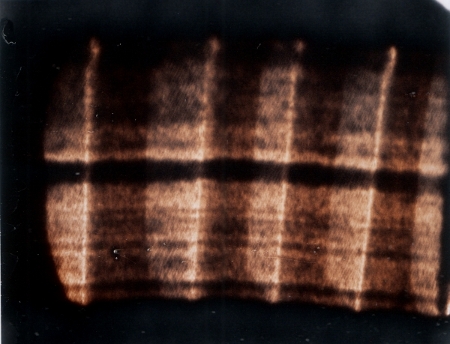 Thought-o-graphic result received by Sam Ashley
Thought-o-graphic result received by Sam Ashley
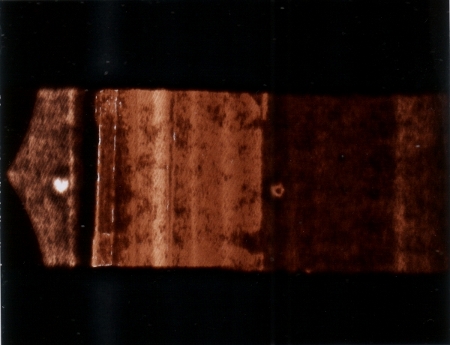 Thought-o-graphic result received by Barbara Breitenfellner
Thought-o-graphic result received by Barbara Breitenfellner
Encouraged by the amount and diversity of results of this experiment, I started to investigate simultaneously into various different directions, including telepathy, the storage of magnetic fluidum in different selected objects, under water exposure through a hydrophone, direct salt water exposure, exposure of plants and trees, the human body and further personal objects, like books, finger rings, pockets and bags. The field for investigation is literally unsaturable and leaded me- and still does! - to evermore open doors and possibilities.
Telepathic Exposure from Dundee (Scotland) to Berlin (Germany)
Lindsay Brown exposed over night onto various photographic materials, such as black and white photographic speed paper (Adox\Easy Print), b&w instant image material (Fuji FP 3000) and b&w 120 rollfilm ( Ilford 3200 ASA). While the rollfilm didnt show anything visible the other two developed as you can see below:
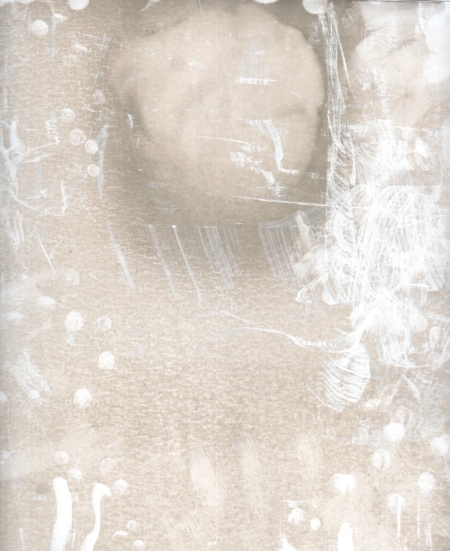 Photographic paper, 12h exposure, standard deveolpment process, development time 5 minutes
Photographic paper, 12h exposure, standard deveolpment process, development time 5 minutes
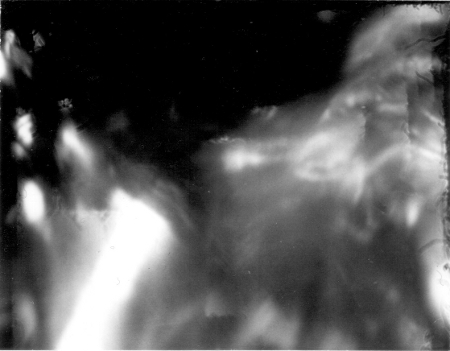 Fuji PJ 3000 B, 12 h exposure in Kamera
Fuji PJ 3000 B, 12 h exposure in Kamera
Exposures of a silver finger ring with malachite
9 snippets of b&w photographic paper were enclosed in black plastic and mounted underneath the green malachite stone of my finger ring. I wore the sensitive ring for one day and one night, without taking him of. Even though it was a b&w paper, it developed different colours.
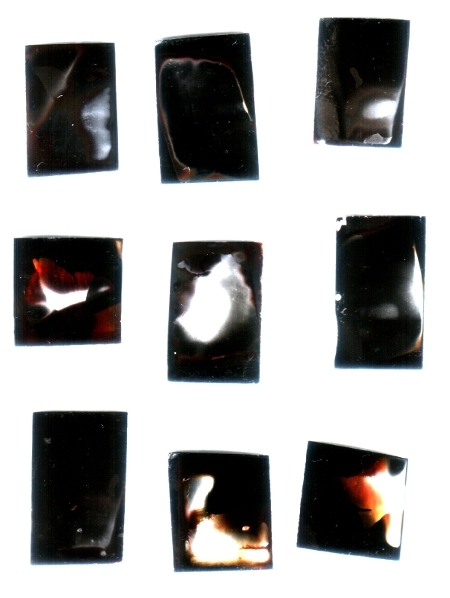 Experiment underwater with a Hydrophone
Experiment underwater with a Hydrophone
Attached to a Hydrophone (underwater microphone) , light,- and water proof, tiny pieces of b&w photographic paper where exposed to the underwatersoundscape about 15 minutes in Serpentine Waters in London.
Environmental longtime exposure
Over a period of several days, light proof sealed photographic paper has been hidden and/or attached to an environment of interest. After days of exposure the remainings - sometimes all, sometimes just a few, or even unwrapped - by suspecting or curios persons - could be recollected and subsequently developed.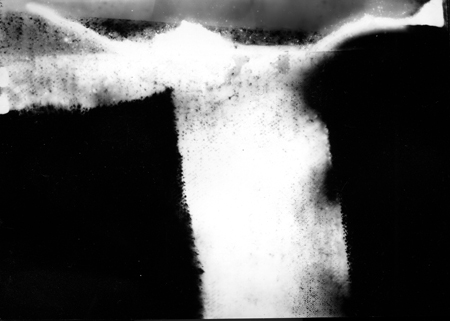
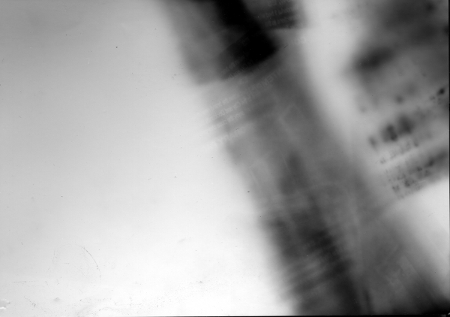
Creatures of thought
Exposures through water, through sand (including light)
Photographic paper is a rather patient absorber, and therefore very suitable for these kind of experiments, as it is not as sensitive as fellow film materials. In the thought-o-grahical context of these experiments, light has a double purpose. On one hand it naturally exposes all light sensitive materials and on the other hand it acts as a carrier of something that I will call creatures of thought (whatever these creatures of thought might be and wherever they might come from and whatever they might tell me), I will maybe never know. It is also not important.
The inclusion of light in these experiments allows or even enables these creatures of thought to be absorbed and/or reflected and finally revealed throughout chemical processing on the very photographic paper.
In my earlier thought-o-graphic experiments where light was strictly excluded during the entire process, I was (and still am) concerned with objects or subjects that reflect their specific memory, history, feelings, atmosphere, thought forms etc.. onto the photographic paper. Most of the time in direct contact, the object or subject emits or transmits, the paper absorbs.
In both cases the sensitive layer acts as a revelation or mirror of the presence of these alleged emissions or respectively creatures of thought.
PS: Drawing with light, reflection and absorbation, creatures of thought
